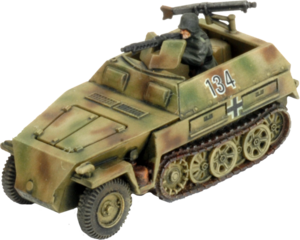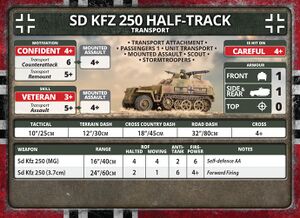SdKfz 250: Difference between revisions
1d4chan>Lord Of The Lemmings Created page with "The SdKfz 250, aka the "Special Motor Vehicle" was a German half track in service in the Axis powers, primarily in the Wehrmacht. It was a solid workhorse vehicle that served..." |
imported>Administrator m 8 revisions imported |
||
| (9 intermediate revisions by 6 users not shown) | |||
| Line 1: | Line 1: | ||
The SdKfz 250, aka the "Special Motor Vehicle" was a German half track in service in the Axis powers, primarily in the Wehrmacht. It was a solid workhorse vehicle that served throughout the conflict. | [[File:GBX129-03.png|thumb|"Vatch me pop a vheelie Hans!"]] | ||
The '''SdKfz 250''', aka the "Special Motor Vehicle" was a German half track in service in the Axis powers, primarily in the Wehrmacht. It was a solid workhorse vehicle that served throughout the conflict. | |||
==Early war== | |||
[[File:SD Kfz 250 Statcard.jpg|thumb|left|Die Stats]] | |||
==Mid War== | |||
==Late War== | |||
==IRL== | ==IRL== | ||
[[File:Sdkfz250 snowy.jpg|thumb|"I'm freezing my balls off out here."]] | |||
When the Germans launched WWII they were big on their ''Blitzkrieg'' tactics, which took the rest of the world by surprise. ''Blitzkrieg'' relied on three main pillars: 1) close collaboration by all type of troops (aka. combined-arms operations); 2) ''Auftragstaktik'', at the time a rather novel concept of giving a (insert unit here) leader a goal and a time by which said goal had to be met rather than an inflexible battle-plan; and 3) high mobility. And while the two first could be easily propped up with training, the third was ''one hell of a fucking thorn in their side'' for the entirety of the war. Despite the myth of a highly mechanized ''Wehrmacht'' during WWII, the truth is that there were simply never enough vehicles nor fuel to go around and that the main locomotion systems were (in this order) trains, feet and horses. Sure, they had the [[SdKfz 251]] heavy-duty half-track available, but not in sufficient numbers; and that one was being put to way better use in front line combat. | |||
The 250 was | Thus, in order to address the problem of lack of transport vehicles, and especially 'front-line capable' vehicles (up to a point, at least) to allow the infantry and scout troops to keep up with the Panzers, German High Command put out a tender for a brand-new ''Schützenpanzerwagen'' to complement and hopefully supplement the unarmored and weaponless but ubiquitous Opel Blitz truck. | ||
The DEMAG society, who had experience already with light, unarmored half-tracks, was selected to produce the SdKfz 250. And, all other things being equal, DEMAG delivered brilliantly: the SdKfz 250 was reasonably fast, rugged, tough, easy of use, could cross pretty much every type of terrain, and offered adequate protection from shrapnel and small arms to the squad it carried. Originally, it was only intended to act as a transport for infantry and especially ''Spähtruppen'', allowing the infantry to keep up and act as the eyes and ears of the heavier tank divisions. The original version sported only two machineguns to support the squad of soldiers it carried and was intended to leg it as soon as enemy positions were confirmed. But, the vehicle proved itself reliable and extremely popular with the soldiers, and over the course of the war a staggering amount of different versions were created; from command vehicles with multiple radios for officers to coordinate their troops, to dedicated scout vehicles without troop transport capacity, to AA vehicles, to artillery observation vehicles, to mortar carriers, to tank hunters sporting 37mm, and even 75mm cannons mounted into it. In a way, it is a symbol of Germany during WWII: never really perfect but readily adaptable to the task at hand. | |||
{{Template:German Forces in Flames of War}} | {{Template:German Forces in Flames of War}} | ||
Latest revision as of 15:58, 22 June 2023

The SdKfz 250, aka the "Special Motor Vehicle" was a German half track in service in the Axis powers, primarily in the Wehrmacht. It was a solid workhorse vehicle that served throughout the conflict.
Early war[edit | edit source]

Mid War[edit | edit source]
Late War[edit | edit source]
IRL[edit | edit source]

When the Germans launched WWII they were big on their Blitzkrieg tactics, which took the rest of the world by surprise. Blitzkrieg relied on three main pillars: 1) close collaboration by all type of troops (aka. combined-arms operations); 2) Auftragstaktik, at the time a rather novel concept of giving a (insert unit here) leader a goal and a time by which said goal had to be met rather than an inflexible battle-plan; and 3) high mobility. And while the two first could be easily propped up with training, the third was one hell of a fucking thorn in their side for the entirety of the war. Despite the myth of a highly mechanized Wehrmacht during WWII, the truth is that there were simply never enough vehicles nor fuel to go around and that the main locomotion systems were (in this order) trains, feet and horses. Sure, they had the SdKfz 251 heavy-duty half-track available, but not in sufficient numbers; and that one was being put to way better use in front line combat.
Thus, in order to address the problem of lack of transport vehicles, and especially 'front-line capable' vehicles (up to a point, at least) to allow the infantry and scout troops to keep up with the Panzers, German High Command put out a tender for a brand-new Schützenpanzerwagen to complement and hopefully supplement the unarmored and weaponless but ubiquitous Opel Blitz truck.
The DEMAG society, who had experience already with light, unarmored half-tracks, was selected to produce the SdKfz 250. And, all other things being equal, DEMAG delivered brilliantly: the SdKfz 250 was reasonably fast, rugged, tough, easy of use, could cross pretty much every type of terrain, and offered adequate protection from shrapnel and small arms to the squad it carried. Originally, it was only intended to act as a transport for infantry and especially Spähtruppen, allowing the infantry to keep up and act as the eyes and ears of the heavier tank divisions. The original version sported only two machineguns to support the squad of soldiers it carried and was intended to leg it as soon as enemy positions were confirmed. But, the vehicle proved itself reliable and extremely popular with the soldiers, and over the course of the war a staggering amount of different versions were created; from command vehicles with multiple radios for officers to coordinate their troops, to dedicated scout vehicles without troop transport capacity, to AA vehicles, to artillery observation vehicles, to mortar carriers, to tank hunters sporting 37mm, and even 75mm cannons mounted into it. In a way, it is a symbol of Germany during WWII: never really perfect but readily adaptable to the task at hand.
| German Forces in Flames of War | |
|---|---|
| Tanks: | Panzer II - Panzer III - Panzer IV - Panther - Tiger - Tiger II - Panzer 38(t) - Captured Tank Platoon (Germany) |
| Transports: | SdKfz 250 - SdKfz 251 - Opel Blitzwagen |
| Infantry: | MG34 Platoon - AT-Rifle Team - Assault Pioneer Platoon - Grenadier Company - Fallshirmjager Company |
| Artillery: | PaK-40 Anti-Tank Gun - Hummel - Panzerwerfer 42 - Wespe - Grille - PaK-43 - 12cm Mortar - 8cm Mortar - 21cm Nebelwerfer 42 - 30cm Nebelwerfer 42 |
| Tank Destroyers and Assault guns: | Marder - StuG III - Jagdpanzer IV - Nashorn - Elefant - Jagdtiger - Brummbar - Hetzer - Sturmpanzer II Bison |
| Armored Cars: | SdKfz. 234/2 'Puma' - Sd.Kfz 222/223 - SdKfz. 231 |
| Aircraft: | JU-87 Stuka - HS-129 - ME-262 Sturmvogel |
| Anti-Aircraft: | Flak 88mm - Flakpanzer IV Wirbelwind & Ostwind |